|
Cecil Allen was born near Glencoe, OK in 1904. He signed the Tucson Register Monday, August 22, 1932. He was flying solo in Travel Air NC414W. He was based in Los Angeles, CA, eastbound from LA to an unidentified destination. He was among a group of sixteen other pilots landing the same day that were part of the “mob” headed east during the 1932 National Air Races (Cord Cup race). Cecil ultimately placed 12th, winning $100. He died almost exactly three years later on August 30, 1935 at Van Nuys, CA at the beginning of the Bendix competition that was part of the National Air Races that year.
Below, three images, all from the private collection of Lily Mae Miller O'Rourke , which were gifted to donor Alessi (right sidebar). Allen had a life going for himself in sales, and he was engaged to an attractive fellow pilot, Aline Miller.
Ms. Alessi says about the first photograph, left, "Studio shot , hand tinted. Presumably a gift to my Great Aunt (His Fiancee) Aline Miller, (Signed) 'Yours Always, 12/25/29 Cec'. Studio or photographer.... 'Paralta' LA (Los Angeles, presumably)."
Cecil Allen, December 25, 1929
(Source: Alessi)
 |
Cecil Allen, Date Unknown
 |
The right-hand photograph is signed, "To Joe and Noonie (faded) with best wishes, Cec". Ms. Alessi states that this photo was, "...given to my grandparents, Joseph and "Noonie" O'Rourke aka Lily Mae Miller."
Our third photograph is described by Ms. Alessi, "Cecil A. Allen and Aline Miller, Engagement Portrait, circa 1930, Hand lettered: Stockton (Photography Studio?) Hollywood." Ms. Alessi now owns the leather jacket worn by Aline Miller.
Cecil A. Allen and Aline Miller, Engagement Portrait, Ca. 1930
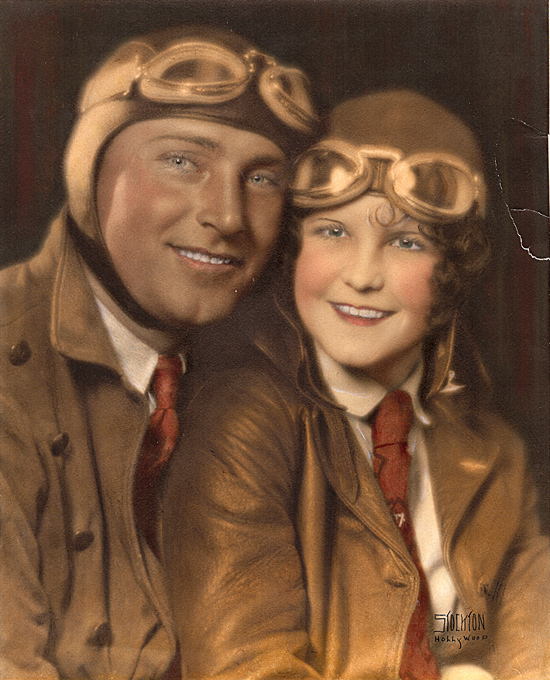 |
In the 1935 Bendix, he flew the Granville Brothers' Gee Bee R-1/2 hybrid, NR2101, called the "Spirit of Right" from Burbank airport. At the link you'll see the name painted on the airplane. Its name was related to a religious group that sponsored him for the race.
Allen took off, departing in an early morning fog. The "Spirit of Right" crashed in a potato field about a mile east of the airport. While it might appear that the fog was a factor in his death, it is believed to be the weight and balance of the airplane that was the cause.
Against the counsel of the Granville family, Allen installed a larger fuel tank well aft of the center of gravity. Upon takeoff, witnesses reported seeing the elevators in full deflection and the airplane behaving in an unstable manner. He was 31 years old at the time of his death.
Four years earlier, Allen, a Los Angeles-based salesmen, and Don Moyle attempted to fly the Emsco B-3, NR153W (Grand Central Air Terninal Register airplane, pictured in the Klein Archive in the "people" section here), named the Clasina Madge, from Japan to the United States. They took off from Japan on September 8, 1931. Inexperienced, they got lost and landed in Siberia. Ms. Alessi provides insight based on family records, "Cecil and Don did not 'fly around for a day' as is reported elsewhere. A storm forced them down on an uncharted island where they survived for several days (approximately 5) by making broth out of leftover chicken bones and clams they found.
"According to Cecil's own writings, they fashioned a slingshot out of a pair of pliers and shot down seagulls. Then they waited for the knocked out birds to drift onshore. Eventually they built a small fire using leaked engine oil and melted the ice off the engine parts, warming it up enough to get it started by hand propping.
"They made their way to a remote coastal village in Kamchatka where they were stuck until a freighter docked nearby. They put fuel from the freighter into the aircraft [paint thinner, as suggested below?] and after a few short test runs, decided it worked well enough to try to continue their flight.
"In the USA there had been memorial services for them, as no one thought they could still be alive. Wire communications went through several translations and American newspapers reported the lost flyers were alive. They landed in Washington after Herndon and Pangborn had gotten the credit for the first non-stop Pacific crossing." Another incomplete account appears here, which mentions the callowness with which they began their flight.
Indeed, the Clasina Madge reached Tacoma on September 25, 1931. From the Monthly Weather Review, September, 1931, page 364, comes this brief statement, also incomplete, regarding their flight.
| Th Moyle-Allen airplane flight over the northwestern Pacfic.- On September 8, Don Moyle and Cecil A. Allen, of California, took off from Sabishiro Beach, Japan, 375 miles north of Tokyo, attempting a nonstop flight of 4,465 miles to Seattle. They were thereafter lost until it was learned 10 days later that they had been forced down by stormy weather, landing upon a remote island of the western Aleutians. After seven days, they hopped off for Siberia, landing on the 17th on the Kamchatka coast, 1,900 miles north-northeast of their starting point of the 8th. They later flew to Nome. |
To begin their trans-Pacific flight, they traveled first by ship from San Francisco, CA to Tokio [sic]. The following cordial letter, dated July 26, 1931, was written on shipboard by Allen to donor Alessi's grandparents.
Letter, July 26, 1931, Page 1
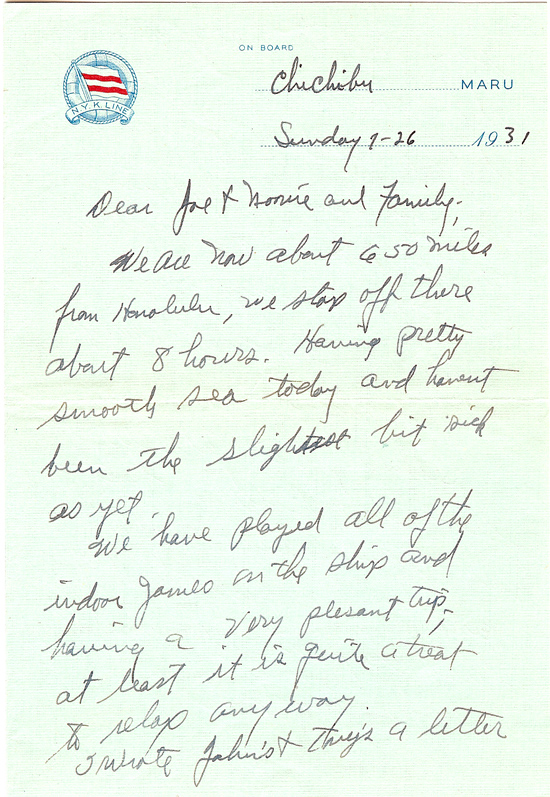 |
Letter, July 26, 1931, Page 2
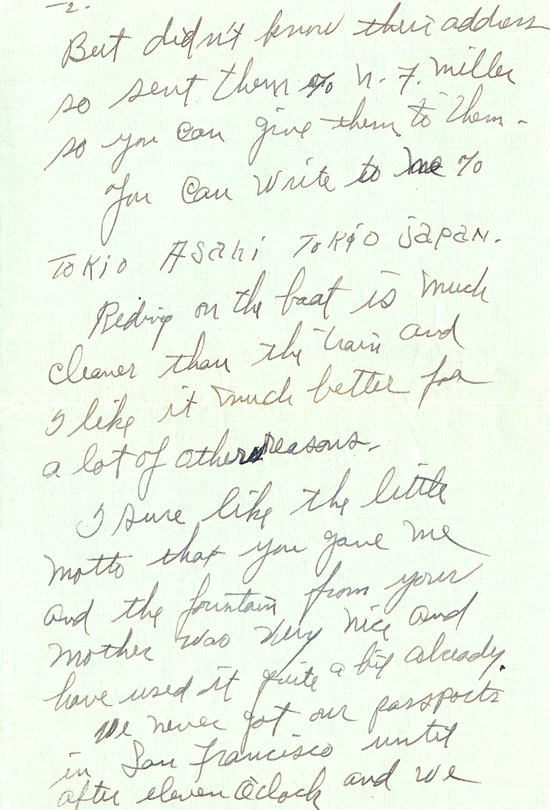 |
Letter, July 26, 1931, Page 3
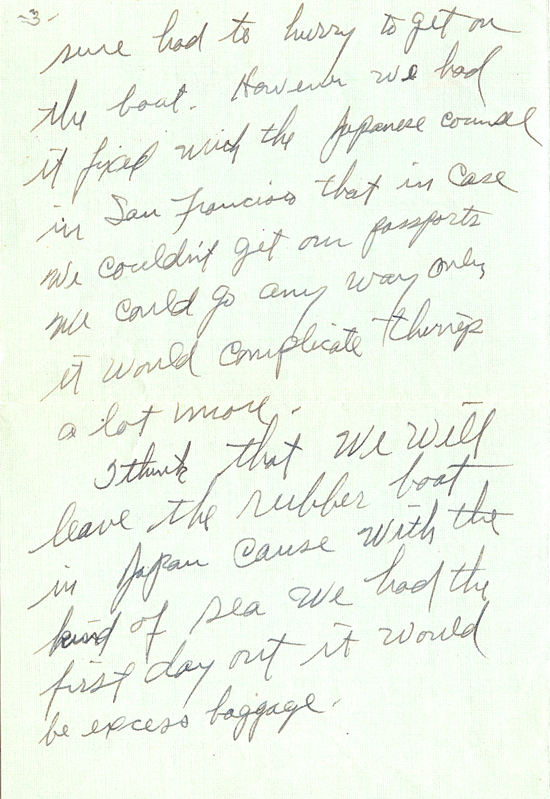 |
Letter, July 26, 1931, Page 4
 |
Note that Allen and Moyle traveled incognito to avoid the news media getting wind of their planned flight. Ms. Alessi states the reason, "...competition was fierce for the unclaimed prize money." As well, for obvious reasons, to leave a rubber life raft behind is not a good decision for a flight over the frigid north Pacific, even if they were guaranteed smooth water for an emergency landing. Interestingly, ChiChibu Maru was built especially for the Yokohama to San Francisco run. In 1942 she became a transport ship for the Japanese Navy and was also used as a hospital ship. About twelve years after Cecil's voyage, on April 28, 1943, while on a voyage from Manila to Singapore she was torpedoed and sunk by the U.S. submarine Gudgeon.
That the flight of the Clasina Madge, from Japan to the United States was a big deal in Japan is illustrated by the following unusual artifact shared with us by site visitor Louis McWhinnie, courtesy of his McWhinnie Collection. It is a kimono from the period that has a likeness of the airplane flying past Mt. Fuji, accompanied by two Japanese planes.
Japanese Commemorative Kimono, Ca. Early 1930s (Source: McWhinnie)
.jpg) |
Below, detail from the kimono.
Japanese Commemorative Kimono, Detail, Ca. Early 1930s (Source: McWhinnie)
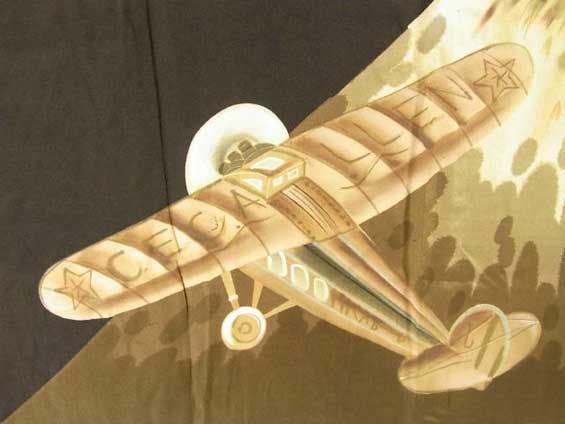 |
Mr. McWhinnie says about his kimono collection, "The kimonos were inspirational, and were only made during a short sixty year period, most were destroyed by the Japanese, and by the allies during the occupation of Japan, as it was forbidden to wear them.
"Many designs were drawn from the news of the day. I guess Cecil must have made a big impression on the Japanese for them to incorporate his heroic deeds onto their textiles. If the young man who wore this kimono is still alive, he would be over 100 years old!"
A comprehensive tabular summary of Bendix Races over the years is presented at the link. Below, a transcription of a news article that appeared in the Oswego Palladium-Times, Friday August 30, 1935 (price 3-cents). Some of the copy was unreadable in the original of this truncated article, that's why I chose to transcribe it. My comments are in [brackets].
TRANSPACIFIC
FLIER KILLED
NEAR BURBANK
Cecil Allen Fails to Gain Altitude
in Fog; Wreckage Scattered
for 500 Feet
EIGHT PLANES STARTED
Amelia Earhart and Roscoe
Turner Seek Record in $12,-
500 Bendix Trophy Event
CLEVELAND, Aug. 30.—UP — Benny Howard, competing in the Bendix trophy race, landed at the municipal airport here at 1.40 p. m. Eastern Standard time, today. He was the first of the contestants to reach Cleveland.
Howard said he would not go on to New York in an attempt to set a new transcontinental record. His unofficial time for the race distance
was 8 hours 38 minutes.
Although Howard was first to arrive here at the scene of the national air races, there was no indication he would win the $10,000 air classic.
Howard's time was 18 minutes slower than the record set in 1932 by James G. Haizlip.
Amelia Earhart left Kansas City at 1:18 p. m. EST.
Col. Roscoe Turner left Wichita, at 11:42 a. m. EST.
UNION AIR TERMINAL, BURBANK, Calif., Aug. 30.—UP—Death claimed Cecil A. Allen early today as he followed eight other planes roaring toward Cleveland and New York in tne annual $12,500 Bendix trophy race.
Allen, 33-year-old former trans- Pacific flier, was killed when his Gee Bee [NR2101, see photograph below] plane crashed a mile away from the terminal, apparently never having gained altitude after diving down the fog bound runway.
[Unreadable] as Amelia Earhart and Col. Roscoe Turner, sped eastward, unaware of the tragedy behind them.
Trouble also overtook Jacqueline Cochrane, New York aviatrix, who landed at Kingman. Ariz., at 10 a.m. (Eastern Standard time) and said she would remain there. Other than to say her radio quit, she would make no comment on dropping out of the derby.
Allen's speedy craft grounded in a field just off [unreadable] boulevard in North Hollywood, plowing a deep furrow in the ground before it was demolished and its wreckage scattered for 500 feet.
The pilot obviously had no time to save himself, so quickly did his plane hit.
Flew Across Pacific
Allen flew to fame when he and Don Moyle attempted a nonstop flight across the Pacific in 1931. Battling storms and fuel shortage, they took a month to fly from Japan to Tacoma, Wash., after being forced down on a bleak Aleutian island and then flying to the Siberian coast for paint thinner. which they used as fuel. Today's flight was his first experience in a transcontinental speed dash.
His ship, the 'Spirit of Right", was sponsored by a religious group. A crowd- estimated at 10,000 persons
saw the takeoffs.
Miss Earhart was accompanied by Paul Mantz. She announced before departure that they were merely "out for a ride" and had no intention of competing for the Bendix prize money. They were in the plane she recently flew from Honolulu to Oakland, Calif. [January 11, 1935, NC7952]
Fairly good weather conditions were promised the pilots after they once cleared the mantle of fog here, and it was predicted that a time of close to nine hours for the trip of those continuing to New York could be expected, which would shatter Col. Roscoe Turner's cross country record of 10 hours, 2 minutes.
The takeoffs were made without mishap, although Miss Jacqueline Cochrane, carrying 97 gallons of gasoline, missed the runway by 300 feet at the tail end, and came so perilously near failing to clear the field, the fire department rushed down the length of the airport be-
(Continued on Page Ten) |
Below is a photograph of the Gee Bee NR2101 as flown by Allen in the 1935 Bendix Race. Allen is standing in the cockpit; an unidentified gentleman on the ground leans in for a conversation. Note the oil streaks on the fuselage and the shadows in the foreground of the crowd assembled to see this unique airplane. The photograph comes to us courtesy of site visitor Betty Brown. Further details about the airplane are at its link.
NR2101 with Cecil Allen at Top, Date & Location Unknown (Source: Brown)
 |
Interestingly, above the bird's head on close examination of the original you can see a halo with musical notes running around it. Site visitor Betty Brown offers the following interpretation of the notes as painted (I believe there is another note attached to the third quaver). If that is a neutral clef after the G-clef, then the notes would be pitchless, perhaps like a percussive bird call, something like this: "chak, Chak, CHAK -- chak, CHAK -- chak, CHAK."
Interpretation of Musical Notes on Fuselage Bird Logo (Source: Brown)
 |
BACK STORY
As happens sometimes, the back story is just as interesting, tragic, poignant and frustrating as the main subject. Cecil Allen's fiance, Aline Miller, was not a D-M Register pilot, but she did land at Clover Field, at the link. Her fate was intertwined with Allen's. Although the history is blurred from the passage of time, this is a compelling human interest story.
Allen's tragedy did not come without precedent. His fiancee, pictured above and below, was a prominent and proficient pilot in her own right. She worked in testing and sales for the Emsco company at Downey Field on Lakewood Blvd. in Los Angeles. She was respected for her work and was a colleague and equal of other members of the flying community on the west coast, both male and female. Below, with Patty Willis (not a D-M Register pilot).
Patty Willis (L) & Aline Miller, Ca. Early 1930s
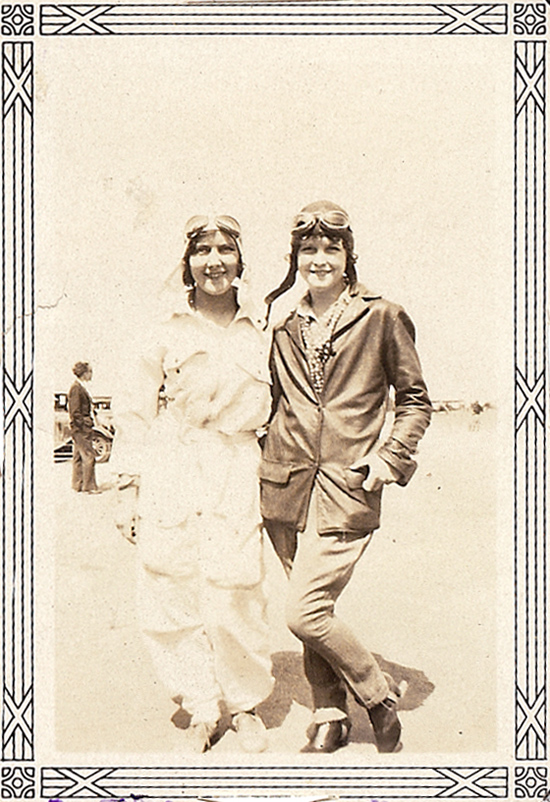 |
Besides her corporate flying work, she became a flight instructor, and (possibly?) she was the youngest air transport-rated female pilot in the country at the time she was certificated (stated as February 6, 1931 in the news article below).
The respect shown her as an instructor is verified by this "first flight" pin presented to her by a grateful first student, Ken Feather. This is a genuine article of white gold with two crescent sapphires and a round blue diamond.
"First Flight Pin," Ca. 1930, Front
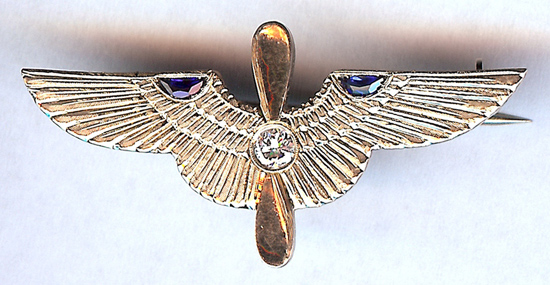 |
Mr. Feather was related to the Doheny family of Los Angeles, CA, whose money came from the burgening west coast oil business of the time. He could well-afford the pin, even in the face of the Great Depression. The back of the pin, below, is engraved, "FROM YOUR FIRST STUDENT KEN".
"First Flight Pin",,Ca. 1930
 |
Further, Aline was a member of the Betsy Ross Corps (BRC), a women's flying association organized by Opal Kunz. Kunz' husband was a Tiffany vice-president and gem expert, thus the design and execution of the organization's wings, below. Please direct your browser to Opal's page to understand better the mission and dedication of the BRC of which Aline Miller was a part. This particular pin has the enamels missing from the stars. Over on Opal's page there is another photograph of a BRC pin sent in by a site visitor which shows the red, white and blue enamels intact.
Betsy Ross Corps Official Insignia, Ca. 1930
 |
Betsy Ross Corps Official Insignia, Reverse
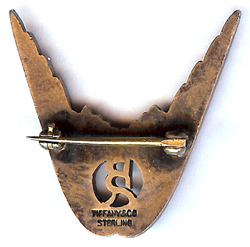 |
Aline Miller, 1930
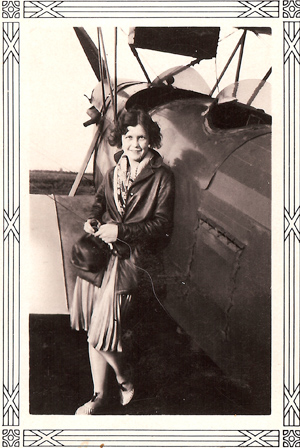 |
Photograph, at right, taken from an unusual rear angle, shows Aline standing behind the port wing of what appears to be a Waco Model 10 or GXE (note landing gear strut passing down in front of the lower wing). The photo is dated 1930.
A bit of detective work shows us that Aline was flying at least one Waco during 1930. Below is a page from the Santa Monica, CA Clover Field Register from May, 1930, courtesy of John Underwood, which is in your Webmaster's collection. It shows Aline's signature toward the center of the page.
She was flying Waco 5107, which was a GXE model, S/N 1501. It is unknown if it is the same airplane as in the photograph.
Regardless, please note there are several other female pilots who signed this same page on May 9th, including Register pilots Clema Granger and Gladys O'Donnell. This appears to be a rendezvous at Santa Monica, as most of the women arrived from different places. They were all headed for Culver City from there. John Underwood states about the rendezvous, "That occasion was, I believe, the re-dedication after Margaret Perry took over the Culver City Airport lease from the McAdoo interests. Perry had in mind making Culver City an airfield catering to women as well as men. She operated a flying school with a Fleet and a Spartan for a year before getting herself re-married, this time to a Mr. Cooper, and selling out to Stan Williams dba [doing business as] Los Angeles Flying Sve."
Thirty-two airwomen participated in the re-dedication event, which included spot-landing and other competitions.
Clema's husband and Register pilot, Jim, appears lower on the page on May 16th flying the Swallow NC8187.
Aline Miller's Register Entry, Clover Field, Santa Monica, CA, May 9, 1930
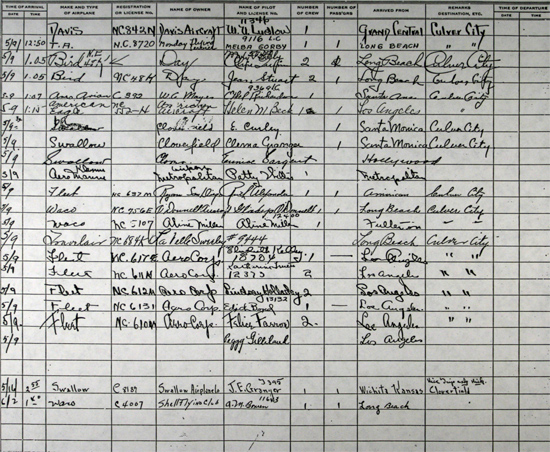 |
One of the special serendipitous juxtapositions that happen to me as I work in the realms of old Airfield Registers is illustrated in the photograph below. The photograph was taken at the 60th annual conference of the American Aviation Historical Society (AAHS) held in Glendale, CA in February, 2016. It shows me on the right with the great-grand niece of Aline Miller.
Your Webmaster (R) With Miller Great-grand Niece, February 13, 2016, GCAT (Source: Webmaster)
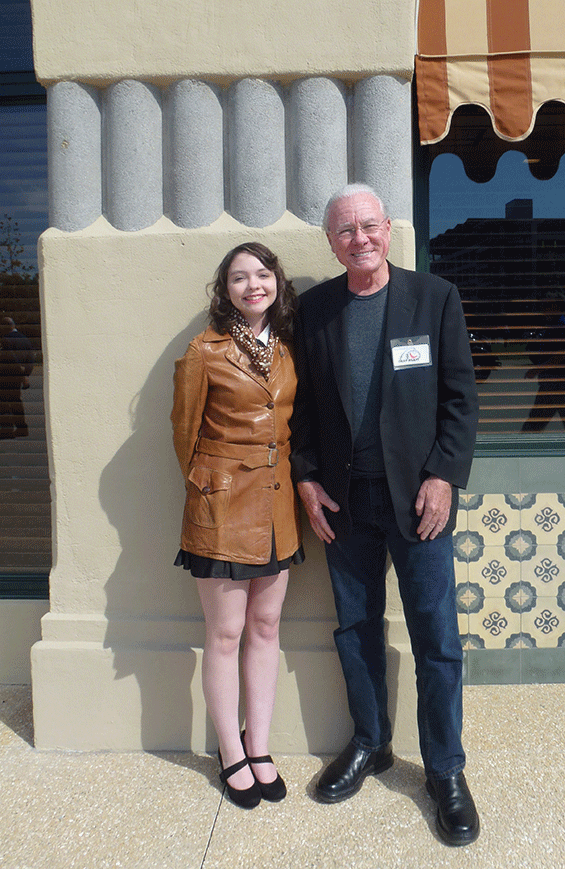 |
Despite the architectural details of the newly restored GCAT building, the important thing is this. The jacket she is wearing belonged to Aline Miller. From the design of the patch pockets, it doesn't seem to be the same jacket as several of the images above. Note, especially, the photograph of Miller with Patty Willis.
Close-up Showing First Flight and BRC Pins (Source: Webmaster)
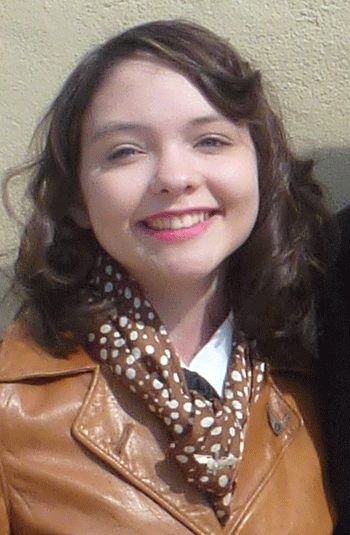 |
However, the closeup, right, of the neckline shows the "First Flight" pin and the Betsy Ross Corps pin exhibited a few photos above. Both are perfectly stylish and wearable today. And, if you look again at the photograph of Miller with Patty Willis, above, you'll see that the scarf is the same! As well, a pleasant, winning smile seems to run in the family.
Despite Miller's skills as a pilot, and her experience in the cockpits of a number of airplanes, Aline was killed about ten months after her visit to Clover Field, above. In March, 1931, at Grand Central Air Terminal, she was involved in a crash of an Emsco B-7. The circumstances and proximal causes of the accident remain contentious to this day between the news and popular presses, and the facts around the flight as understood by the Miller family. What follows is what I think is a balanced exposition of the facts pertaining to the crash as best I know them.
The media perpetuated the story that Aline was young and inexperienced, which was not true: young, perhaps, but not inexperienced. Her family contends that she was killed due to reckless behavior by her passenger that day. What evidence is there one way or the other?
Sexism was rampant in the media of the era. I’ve seen it time and again in my research related to the 42 female pilots who signed the Register. The media just couldn’t get used to the idea that women could fly, be employable, compete and WIN on their own merits. The press had a way of subordinating or trivializing the women by talking about “girl flyers,” “Powder Puff Derby” (thanks to Will Rogers), or linking the women to their husbands, or even mechanics, in an effort to lend credence to their capabilities!
Boyne, in his 2001 book (cited left sidebar), states, "The first B-7 was destroyed in an accident at Grand Central Air Terminal on March 22, 1931. A relatively inexperienced Emsco demonstration pilot, 22 year old Ailine [sic] Miller, had just picked up veteran movie pilot Evan [sic] de Villiers for a joy ride.
"The plane was seen to rise sharply to about 400 feet, as if the pilot were showing off a bit, then stall and crash, breaking apart just aft of the rear cockpit. The entire forward portion was demolished, and the pilots died on the way to the hospital."
Another, slightly more accurate, view of the story was published in the Glendale News-Press, below. It makes note that Aline received her Air Transport rating February 6, 1931, about a year before the accident. The Air Transport rating was an exacting and exhausting achievement at the time: not everyone qualified.
Glendale News-Press, March 22, 1931
 |
Her passenger, Ivan [sic] De Villiers, is cited in the article as being a, "... stunt flyer for motion pictures...." and a, "...member of the Thirteen Black Cats and White Phantoms and had performed many daring stunt flights in motion pictures." I find no mention of De Villiers' involvement with either organization in the Wynne reference in the left sidebar. There are no relevant Google results for either Ivan or Evan De Villiers. His "stunt flying" is believed by Miller's family to be as wing walker, not as a pilot.
Aline was called a diminutive aviator. Indeed, she was not a large human being. Everyone assumed De Villiers was a licensed pilot, but I found no evidence that he was. As was a common perception of the time, put a “girl” and a man in a plane and obviously the man has to be the one in charge, until something goes wrong.
Ms. Alessi, a certificated pilot, states, “…that the reports describe a departure stall at full power - which is consistent with someone grabbing the controls (tandem seating aircraft, she was seated in rear unable to see what he was doing).”
Below, an image from this REFERENCE, volume 5, page 13 of Emsco B-7 S/N 1, NC869N. This is the airplane Miller and De Villiers crashed. There is no statement in the reference regarding the fate of this airplane. There is another image of it at the top of the page for Register pilot Walter Seiler.
Emsco B-7, Serial Number 1
(Source: Juptner, Volume 5, Page 13)
 |
Ms. Alessi continues, “Aline Miller was an employee of the Emsco Aircraft Company, not an inexperienced pilot. Passenger De Villiers was not a pilot, he was a veteran stunt 'Flyer' hence the confusion. He performed aerobatic stunts in movies. … Aline [was] recognized as the first female saleswoman in American aviation. [She] was the demo pilot for that plane. The company would not have placed an inexperienced pilot in that position. She handled the plane without problems until that day.
“Initially the papers reported that the ‘diminutitive aviatrix’ had been unable to control the huge plane [from the image above, it was not a huge airplane], and that perhaps there had been some ‘confusion about the controls’. Not so, he [De Villiers] had no business touching the controls, therefore she was basically, in the eyes of my grandmother, murdered.
It became clear that De Villiers, “… grappled with the controls without her permission or knowledge and my grandmother reported that it came out in a coroner's inquest that he told someone in advance that he was 'going to teach this little girl a thing or two about flying.'
“The investigation supposedly found that the control sticks were physically bent in opposite directions and with witness testimony as to his premeditated intentions, it was plausible that she had struggled fiercely for the controls before the aircraft stalled.
Aline Miller Portrait, Date Unknown
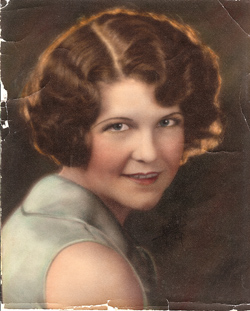 |
“Adding to the confusion was that another couple had crashed at a different airport just minutes apart, the news coverage of both accidents was very sensational and inaccurate, and my grandmother was angry still, fifty years later when she went over the news clippings with me.”
She continues, “I used to doubt some of my Grandmother's tales, but she usually had the goods to back it up. She and Aline were as close as two sisters could be. Losing Aline shaped Lily Mae for the rest of her life, and she would get very fiery when she retold these stories. I also interviewed her brother, my great uncle, who gave me additional documentation.”
“In actuality, and my grandmother was very clear on this, he had been hounding her for a ride for days, weeks maybe even months. My grandmother, to whom she [Aline] was extremely close, reported this to me and said every time she flew into Grand Central he would bother her.
“The estimate is that she had been flying for several years (since the age of 18) and that is what may have prompted De Villiers stunt, the mumbled comment about giving her a little taste of excitement, and that is where my Mom uses the same quote that my Grandmother told me... ‘I'll show this little girl a thing or two about flying!’
“In any case, she told her female passenger [Ms. Hodge, according to the news article above, came to Grand Central with Miller that day] to stay on the ground while she gave ‘that creep’ a quick ride around the pattern.”
Below, a cockpit photograph of Aline Miller. Ms. Alessi states, “This may be the very last photo of Aline. The poem on back is dated on the day [it's actually dated four days later] of [the crash] and probably given to my grandmother ["Noonie"] at Aline's services.” Aline holds one of the wing strut wires between the thumb and forefinger of her left hand. Ms. Alessi's grandmother recalled Aline wearing a white suit on the day of the fatal flight.
Aline Miller, Circa 1932
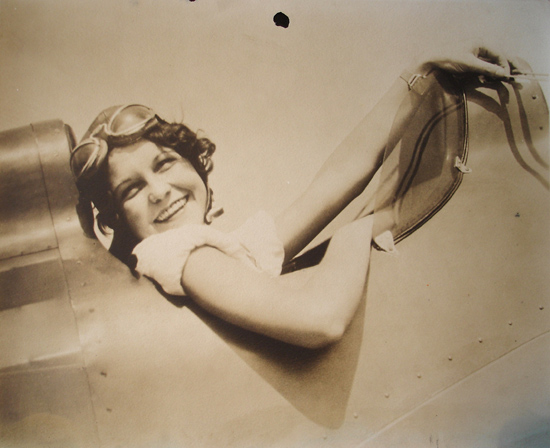 |
However, if you compare the details of the cockpit with the photo of the B-7, above, they are not the same airplane. The cockpit opening and windshield design are more in the likeness of the B-4 model, seen at this link. Note there is just the small side shield. If you play with the contrast of that photo you'll be able to make out the edges of the acrylic. What is the possible history here?
There were two B-7s made. One of them, NC869N, the one Aline crashed, was actually a B-4 converted to a B-7. To what degree it was converted opens the question as to whether, in the photograph above, she was in a B-4 or in the B-4 "converted" to a B-7 which retained the B-4 style cockpit and windshield outline. We may never know for sure. Regardless, it's pretty safe to say this photo wasn't taken on the day of her accident, and the airplane she is posed in "probably" isn't NC869N.
To the poem on the back of the photo, I pushed the contrast in PhotoShop to enhance readability. It was composed by Jean Hodge, friend of Aline, mentioned in the news article, above.
Aline Miller, Memorial Poem, March 25, 1931
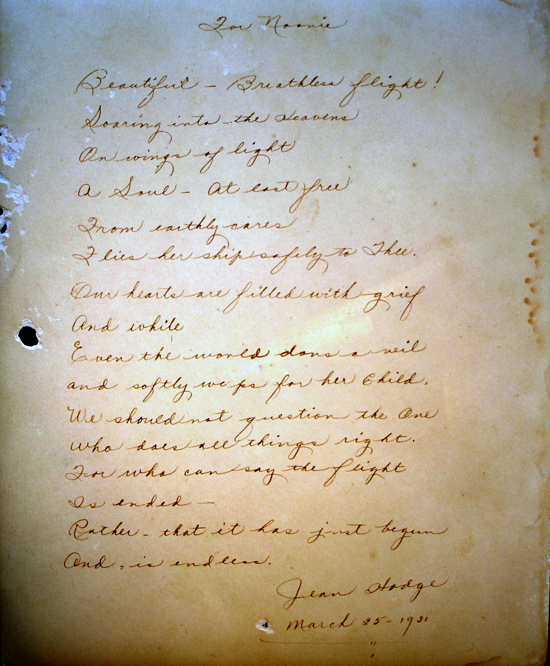 |
Her services were held March 25 or 26, 1931. Internment at Calvary Cemetery, Boyle Heights, Los Angeles, CA.
A sobering finding by your Webmaster came during an examination of the traffic Register for the Grand Central Air Terminal, Glendale, CA. Below, the page for March 22, 1931 records the crash of NC869N. I have underlined the entry by the tower operator whose name was Lygum. He records the landing by the "Emscoe" [sic], the airplane's identification number, and the times of arrival and departure. Curiously, the name "R. Williams" appears in the pilot column. Nothing in any of the documentation I have seen mentions Williams. But Roger Q. Williams was a well-known pilot in the area.
Grand Central Air Terminal Register, March 22, 1931 (Source: Webmaster)
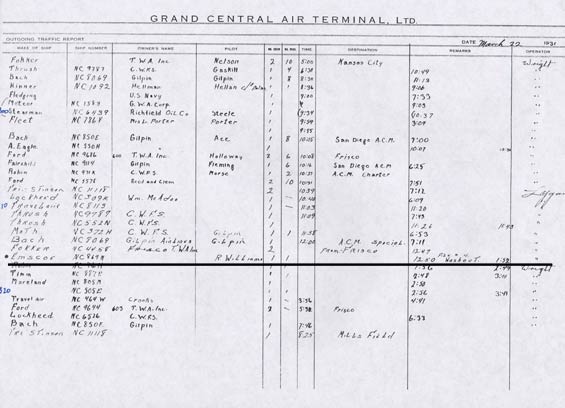 |
Note that one passenger is logged as well as the pilot. The passenger would have been Ms. Hodge. The arrival time of 12:50 and departure time of 1:52 PM corroborates the lunch meeting and postprandial takeoff noted in the news article, above. The tower operator noted "Washout" in the Remarks column of the Register, and references "File #4." Does anyone know the whereabouts or even the existence of File #4? If so, please let me KNOW.
Although unrelated, earlier in the day this page documents visits at Glendale by several Davis-Monthan Register aircraft (Bach NC8069, Fairchild NC9114, Lockheed NC309H, Stearman NC6439) and by Register pilots Dudley Steele, Ace Bragunier and Bill Gilpin.
EPILOGUE FOR CECIL
Ms. Alessi states, “Cecil was reportedly a staunch defender of Aline's skills, the plane's airworthiness, and pushed for an investigation. He was devastated by the loss of Aline. My grandmother inferred that Cecil's choosing of an Emsco craft [Model B-3] later that year for the Pacific flight was no coincidence ... the company designed sturdy and innovative aircraft. His grief over Aline's death cannot be underestimated in affecting his very poor decision to go ahead with the Pacific attempt.”
Ms. Alessi interviewed her grandmother for an oral history project when she was in college. Her grandmother reported that Don Moyle shaved off part of the wooden propeller on the Clasina Madge to reduce drag. She also reported that Cecil used to lash manual ringer clothes washers in the seat of his airplane and deliver them to rural homes in Utah and Arizona in the late 1920s and early 1930s. There is no telling what effect this early air freight operation had on the aircraft’s weight and balance.
Regarding the 1935 Bendix, Ms. Alessi states, “News reports of the day often implied that Cecil and other daredevil aviators like him must have had a death wish or lacked skill and wisdom for doing the things that they did. Certainly, by today's standards, that might be an obvious conclusion. But in the context of early aviation, especially in the 1930's, aircraft design was an experimental process and piloting required a constantly evolving set of skills. Without a doubt, Cecil and his contemporaries took many risks, ignored warnings and defied the odds, improving their own skills and those of future pilots in the process.
"What is clear from direct quotes and his own written words, Cecil Allen understood that the kind of flying he did involved an ever present danger of failure and certain death. That is what all the pilots of the day faced every time they pushed the boundaries of speed, altitude, distance and endurance.
"My Mother [Aline's niece Deirdre] says, 'There were many great stories about Cecil but in essence he was a handsome, reckless, funloving and adventurous young man who liked to push the envelope.' Today we easily recognize the names of those pioneer pilots who were named 'First' to reach a global record or accomplishment.
"Cecil was among the intrepid pilots who were the first to challenge, trying again and again, in an attempt to do something others had not yet done, despite the probability of failure. Though it did not end well for Cecil and Aline, they were among those who paved the way for those of us who followed."
Below, courtesy of the San Diego Aerospace Museum Flickr Stream (SDAM), is a photograph of NR2101 as it lay after Allen's crash. The commentary under the photo was placed there by GeeBee project worker William Munger. Whether he was warned or not, Allen flew an airplane outside its center of gravity (CG) envelope, which led to his death.
Wreck of the GeeBee NR2101, 1935 (Source: SDAM)
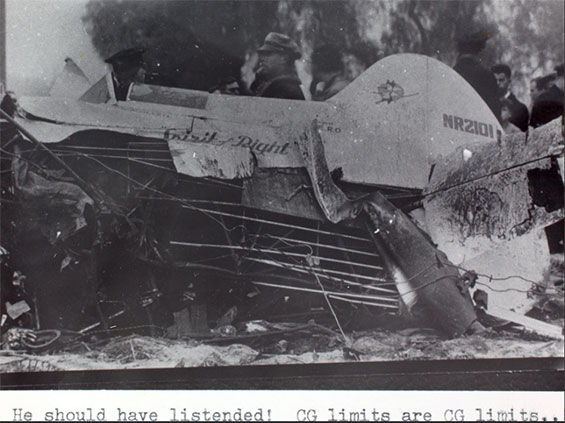 |
---o0o---
Dossier 2.1.182
THIS PAGE UPLOADED: 02/06/08 REVISED: 04/11/09, 07/07/09, 12/23/11, 01/16/12, 07/14/12, 01/24/13, 03/12/13, 01/06/14, 02/23/16
|
